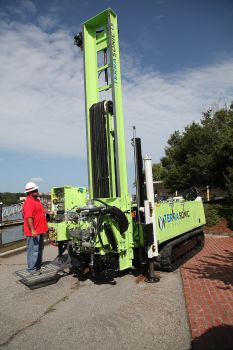Sonic (Vibratory) Drilling

|
| High-Tech Sonic Drill Rig |
"Sonic drilling is also a relatively new technique for subsurface investigations. Sonic drills have penetration rates that can be three to five times faster than conventional drilling, and they do not require the use of drilling mud. The vibratory action of the sonic head produces much lower peak noise levels than top-hole hammers."[1]
"The sonic head, which is larger than a standard rotary head, rotates and oscillates simultaneously, causing the drill bit to vibrate up and down as it rotates. High-frequency resonant vibrations are transmitted from the head through the drill string to the end of the casing and then reflected back; causing the casing to stretch and thin, and to shorten and thicken 100 to 200 times per second. The operator controls the frequencies to match the characteristics of the geologic materials; frequencies range between 50 and 200 hertz (cycles per second)."[1]
"Sonic drilling, as with the ODEX method, is useful in geologic conditions that are difficult for more conventional systems including fractured bedrock, high energy fluvial deposits, and glacial till. In unconsolidated materials, the intense vibratory action causes a thin layer of soil directly around the drill rods to fluidize. The fluidized soil zone extends a maximum of 5 millimeters around the rod, reducing the friction of the drill rods and allowing rapid penetration. Advancing the sampler in stiff, plastic clay soils can cause problems flushing the bit, and drilling through flowing sand can bind the bit. In rock, the bit pulverizes the material, creating dust and small rock particles and allows advancement of the bit."[1]
"The high-frequency oscillation of the driven rods ensures minimal disturbance of the in situ materials, providing high quality, continuous samples that are relatively undisturbed. They have been used to depths of greater than 700 feet (Water Well Journal, January 1998). The sample barrel is 10 feet long, and the core samples are frequently extruded into clear plastic sleeves so the materials can be logged. Split barrels, with and without liners, are used as well; the use of hydraulic extruders can minimize the disturbance."[1]
"The U.S. Army Corps of Engineers has approved the sonic drilling method of advancing a hole through earthen embankments (Engineering Regulation 1110–1–180, 1 March 2006)."[1]
Best Practices Resources
![]() National Engineering Handbook: Chapter 5 - Engineering Geology Logging, Sampling, and Testing
National Engineering Handbook: Chapter 5 - Engineering Geology Logging, Sampling, and Testing
Trainings
![]() On-Demand Webinar: Drilling Plans and Hazard Evaluations for Dams and Levees
On-Demand Webinar: Drilling Plans and Hazard Evaluations for Dams and Levees
![]() On-Demand Webinar: The Practical Use of Geophysics to Assess Dam and Levee Safety
On-Demand Webinar: The Practical Use of Geophysics to Assess Dam and Levee Safety
Citations:
Revision ID: 4048
Revision Date: 10/25/2022
